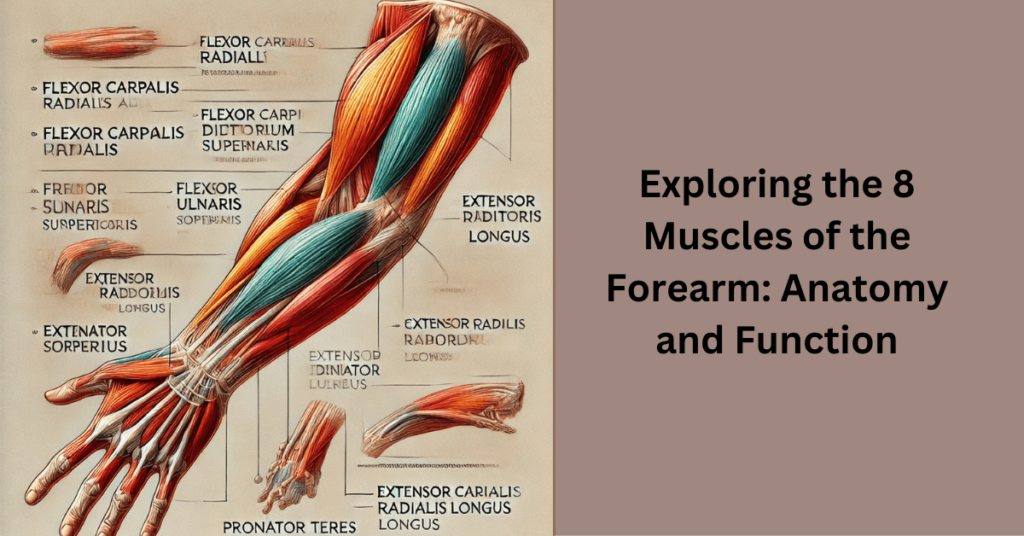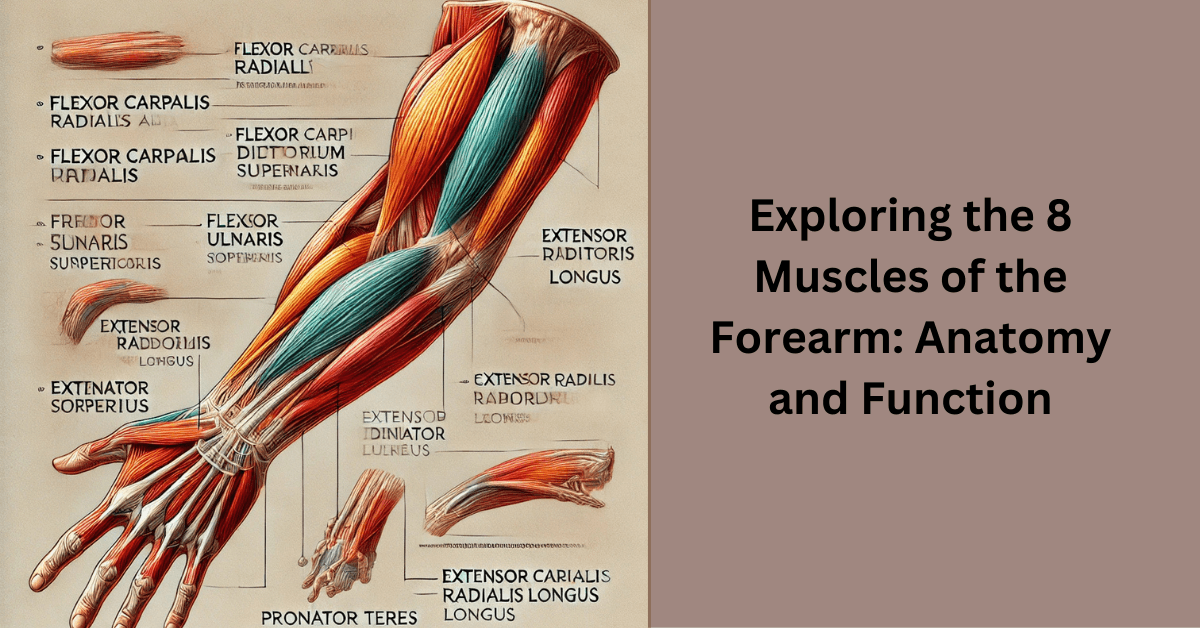Exploring the 8 Muscles of the Forearm. The human forearm is a complex and highly functional structure composed of numerous muscles that enable a range of movements. Understanding these muscles is essential for athletes, medical professionals, and anatomy enthusiasts. In this article, we will explore the eight key muscles of the forearm, their roles, and their significance in daily activities and specialized tasks.

Anatomy of the Forearm
The forearm is divided into two main compartments: the anterior (flexor) compartment and the posterior (extensor) compartment. Each compartment contains a group of muscles responsible for specific actions such as flexion, extension, pronation, and supination. Let’s delve deeper into the eight primary muscles of the forearm and their roles.
What Are the 8 Muscles of the Forearm?
- Flexor Carpi Radialis
- Location: Anterior compartment.
- Function: This muscle flexes and abducts the wrist, making it essential for activities like typing or gripping.
- Significance: Its strong contribution to wrist movement is critical for precision tasks.
- Flexor Carpi Ulnaris
- Location: Anterior compartment.
- Function: Works to flex and adduct the wrist, complementing the flexor carpi radialis.
- Significance: This muscle plays a pivotal role in stabilizing the wrist during forceful activities.
- Flexor Digitorum Superficialis
- Location: Anterior compartment.
- Function: Flexes the middle phalanges of the fingers, assisting in gripping and fine motor tasks.
- Significance: Vital for actions like holding a pen or manipulating small objects.
- Flexor Digitorum Profundus
- Location: Anterior compartment.
- Function: Flexes the distal phalanges of the fingers, contributing to a firm grip.
- Significance: Essential for activities requiring strong finger flexion, such as climbing.
- Pronator Teres
- Location: Anterior compartment.
- Function: Responsible for pronating the forearm, turning the palm downward.
- Significance: Crucial for everyday actions like turning a doorknob or using tools.
- Extensor Carpi Radialis Longus
- Location: Posterior compartment.
- Function: Extends and abducts the wrist, facilitating upward and outward wrist movements.
- Significance: Enhances wrist stability during activities like throwing or lifting.
- Extensor Carpi Ulnaris
- Location: Posterior compartment.
- Function: Works to extend and adduct the wrist, providing balance to wrist movements.
- Significance: Aids in activities that require coordinated wrist motions, such as playing musical instruments.
- Brachioradialis
- Location: Lateral aspect of the forearm.
- Function: Flexes the forearm at the elbow, particularly in neutral hand positions.
- Significance: Vital for lifting objects and supporting elbow joint stability.
The Importance of Forearm Muscles in Daily Life
The eight muscles of the forearm are indispensable for performing various daily tasks. Their contributions include:
- Hand Dexterity: Flexor muscles enable intricate movements necessary for writing, drawing, and playing instruments.
- Grip Strength: Strong forearm muscles ensure a firm grip, essential for lifting, carrying, and holding objects.
- Joint Stability: Both flexor and extensor muscles work in tandem to stabilize the wrist and elbow during physical activities.
- Athletic Performance: Sports like tennis, golf, and rock climbing rely heavily on forearm strength and flexibility.
Strengthening the 8 Muscles of the Forearm
Developing strong forearm muscles improves functionality and reduces the risk of injury. Here are some effective exercises:
- Wrist Curls: Focus on the flexor muscles by lifting a dumbbell with the palm facing upward.
- Reverse Wrist Curls: Target the extensor muscles with the palm facing downward while curling a weight.
- Grip Squeezes: Use a hand gripper or squeeze a rubber ball to enhance overall forearm strength.
- Pronator and Supinator Rotations: Rotate a lightweight dumbbell to strengthen the pronator teres and other rotational muscles.
Incorporating these exercises into your fitness routine will boost the strength and endurance of your forearm muscles.
Stretching for Forearm Flexibility
Maintaining flexibility in the forearm muscles is crucial for preventing stiffness and improving performance. Try these stretches:
- Wrist Flexor Stretch:
- Extend your arm forward with the palm facing upward.
- Use the opposite hand to gently pull the fingers back.
- Wrist Extensor Stretch:
- Extend your arm forward with the palm facing downward.
- Use the other hand to pull the fingers toward the body.
- Forearm Rotation Stretch:
- Place your arm on a table with the palm facing up.
- Rotate your palm downward, feeling a stretch along the forearm.
Regular stretching ensures optimal muscle function and reduces injury risk.
Common Injuries of the Forearm Muscles
The eight muscles of the forearm are susceptible to overuse and strain, especially in athletes and manual workers. Common injuries include:
- Tennis Elbow (Lateral Epicondylitis):
- Affects the extensor muscles due to repetitive wrist extension.
- Symptoms: Pain and tenderness on the outer elbow.
- Golfer’s Elbow (Medial Epicondylitis):
- Impacts the flexor muscles from repetitive wrist flexion.
- Symptoms: Pain on the inner side of the elbow.
- Forearm Strains:
- Caused by sudden force or overuse of the muscles.
- Symptoms: Muscle pain, swelling, and limited mobility.
Preventing these injuries involves proper warm-ups, ergonomic techniques, and gradual increases in activity intensity.
Forearm Muscles and Their Role in Sports
Athletes often focus on strengthening the forearm muscles to enhance performance and prevent injuries. Here’s how the eight muscles contribute to specific sports:
- Tennis: Requires powerful wrist extension and forearm rotation, engaging both flexor and extensor muscles.
- Climbing: Demands exceptional grip strength and endurance from the flexor digitorum muscles.
- Golf: Relies on coordinated wrist movements facilitated by the flexor and extensor carpi muscles.
- Boxing: Engages the brachioradialis for punching power and elbow stability.
Strength training tailored to these sports can maximize performance and reduce strain.
Nutrition for Healthy Forearm Muscles
Optimal muscle health depends on proper nutrition. Include these nutrients in your diet:
- Protein: Supports muscle repair and growth.
- Calcium and Vitamin D: Strengthen bones and prevent fractures.
- Magnesium: Relaxes muscles and prevents cramps.
- Omega-3 Fatty Acids: Reduce inflammation and support recovery.
Staying hydrated and consuming a balanced diet ensures your forearm muscles function at their best.
Conclusion
The eight muscles of the forearm—flexor carpi radialis, flexor carpi ulnaris, flexor digitorum superficialis, flexor digitorum profundus, pronator teres, extensor carpi radialis longus, extensor carpi ulnaris, and brachioradialis—are essential for a wide range of movements and functions. From fine motor skills to athletic performance, these muscles play a vital role in everyday life. By understanding their anatomy and incorporating strengthening, stretching, and proper nutrition into your routine, you can ensure optimal forearm health and performance.

